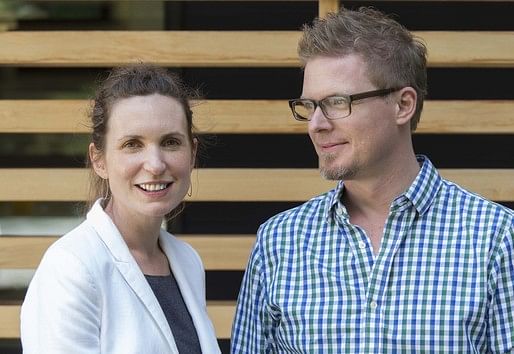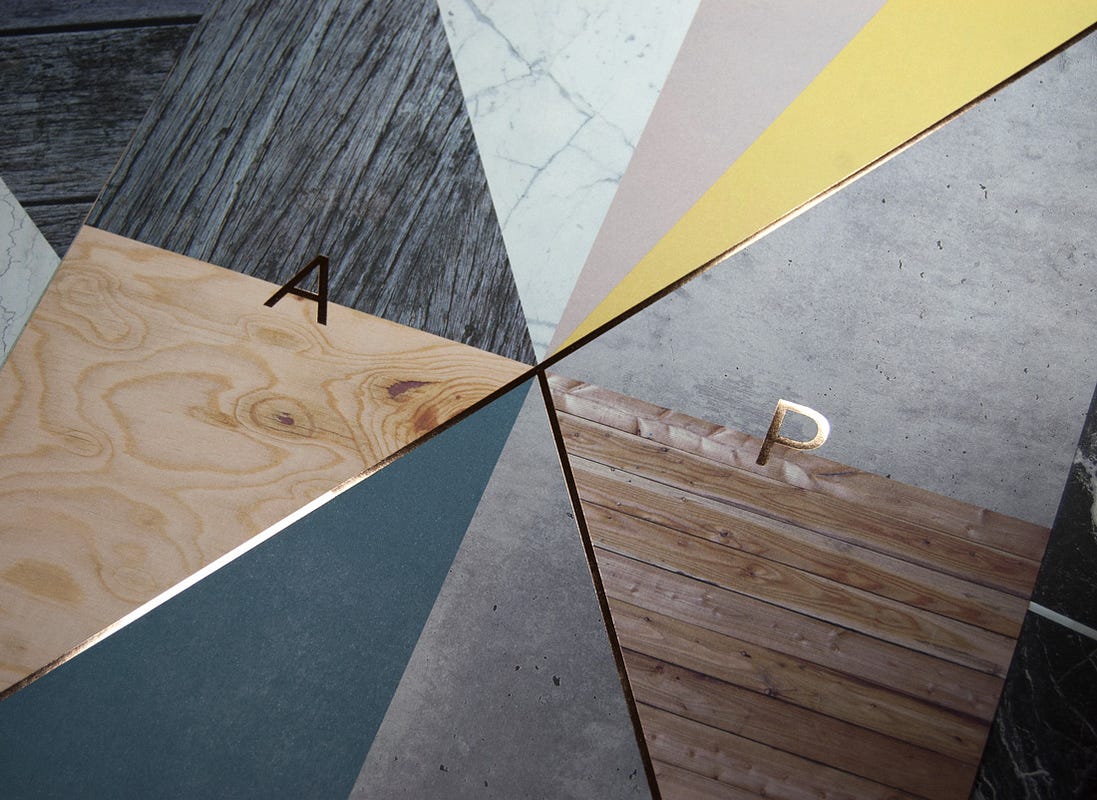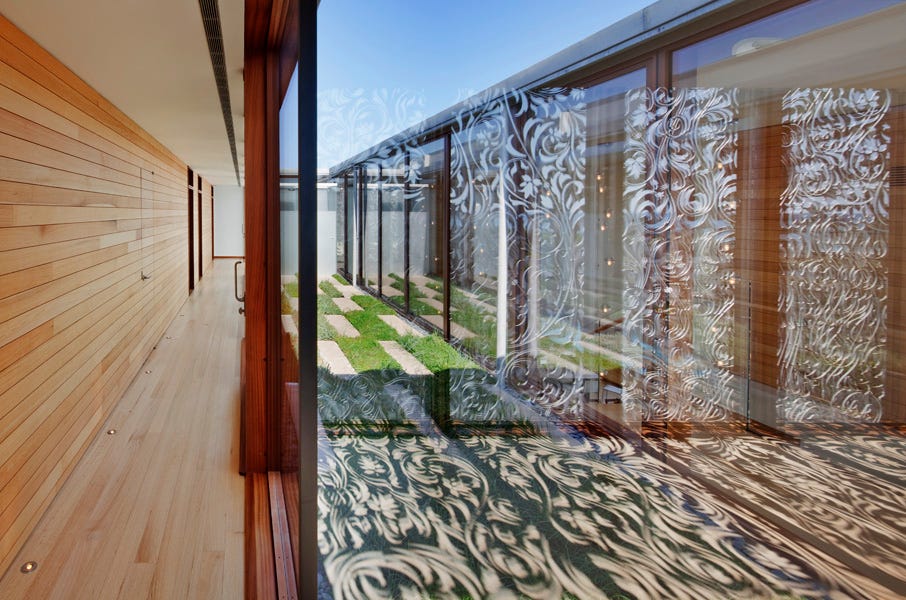

Last week Modelo visited the offices of Aamodt / Plumb a Cambridge-based Architecture firm founded by partners, Mette Aamodt, AIA and Andrew Plumb, AIA. Mette and Andrew first met in graduate school at Harvard GSD. After they gained experience working at both boutique studios and large firms in New York and Boston, they decided to start their own firm in 2007. Nearly eight years later, the venture has matured into an award-winning firm focused on creating beautiful modern homes for a nationwide list of clientele. Despite their busy schedules, the founders took time to reflect on their approach to design and running a business as well as their aspirations for the future.
On their projects
Mette: We focus on modern homes and creative work spaces because those are the places where people spend the majority of their lives. Recently, we completed the Modern Texas Prefab house that is our new benchmark for a design and construction process that we think works really well. We’ve tried a lot of different things in the houses we’ve done and we’re now getting to a place where we have a really good understanding of how we can merge the needs of our clients with the design and execution.
Andrew: That project is a good example of our guiding design principles — creating rich, beautiful spaces through simple forms, materials, and procedures. We had this imperative of, “You must complete this project from demo to handing the keys in twelve months.” It’s a high-end custom home and somewhat large (6,000 square feet), so it became clear to us that the standard process was not going to work.
Mette: Twelve months by the way is extremely fast! Twelve months made us realize, “Okay we really need to think differently about how to do this project.”
Andrew: This led us to design the process before designing the architecture. That meant identifying who the team would be, what their strengths were, and how that was going to influence the project. For instance, we found this company, Bensonwood, they had a process we wanted. They could panelize our design, deliver it, and install it. We figured out how it was going to work first and then that set up some constraints of what you could or couldn’t do and within that we designed the architecture. The end result was that we achieved the schedule and the budget. The frame went up in two weeks, which would normally take months. That got us to think about the idea of “parallel processing.”

Texas PreFab (Photograph by Casey Dunn courtesy of Aamodt / Plumb)
Mette: We borrowed this term from IT, “parallel processing”, which is when you have two servers running at the same time and can get the job done faster. This is where our process distinguished itself from typical “prefab”. Ours is fully customizable and not limited by modules. In this model the foundation work is being done at the same time the panels are being constructed off-site. A typical build is totally sequential. Any delay in one step causes a snowball effect down the line. The plumber can’t come in until the framing is done, the framer can’t come in until the foundation has been poured, so usually it’s just one guy after the next after the next. What we were able to do was have things running in parallel. The panels were shipped to Texas and put up in two weeks after the concrete was dry. That cut out almost two years’ worth of work. That was huge for us and our clients.
Andrew: One of the interesting byproducts of working that way was we had to design and coordinate everything before anything was built. It was very front-loaded in the timeline of a typical project in terms of client and design decisions. It was all modeled in Revit — all worked out first because once you started building the panels, you didn’t want to have surprises. Once that was complete, the construction process was more like an assembly process and everything fit together perfectly. This was really in contrast to another house we did right next door which was a typical high-end house with a long design process, and a long build process. They were both very successful; but in a way they were polar opposites in terms of the process. Our new process cut all the pain out of the traditional approach which was this environment of complexity; there were always things we were constantly working out.

Living Room inside Texas PreFab ((Photograph by Casey Dunn courtesy of Aamodt / Plumb)
On their roles
Mette: They’re definitely emerging. In the beginning we both did everything and then over time we’ve gravitated towards the things we liked the most. Those turned out to be the things we were best at. In the last year I’ve become really interested in marketing and business, so in addition to high-level design, I am also responsible for strategic planning, vision setting, marketing and branding.
Andrew: I’ve taken on the role of a technical director. We both work at a high-level of design and we’re both collaborating to that point. From there we trickle down in different ways. I’m really interested in the workflow of the office and in establishing systems of how we work and thinking about how we can improve in certain ways and how those improvements affect the results of the design process. I am more involved in the day-to-day project work so that’s where I’m focusing my energy.

A new visual identity designed for the firm by TwoPoiints.Net (Courtesy of Aamodt / Plumb)
On their unique approach to design
Mette: We’re really influenced by Nordic design and that is in part due to our backgrounds. I’m Norwegian, I was born in Norway. Andrew’s family is Finnish and Swedish. We’ve both spent a lot of time in Norway and have many family and friends there. The basic principles of Nordic design are simple, authentic, and straightforward. Let your design be inspired by nature and designed for people, for their happiness and enjoyment. These are all values that are important to us in the work that we do and also in how we live our lives and in the way we structure our office and culture. It’s very important to us to have a superior office work environment. This is a bit unusual in the architecture world but we want people to work forty hours a week, have a life, benefits and a retirement plan. We want them to have outside interests, enjoy spending time with their families and be happy when they come to work. It may be a bit “radical” but we want to do great work, enjoy our lives, and make money.
Andrew: We really believe that great work comes from happy people, not from overworked people in a stressful office environment.
Mette: Part of this philosophy is in response to a specific condition. Just before my graduation from the GSD I was in the middle of thesis and I went blind in my right eye. I thought, it was just stress — which was typical for us at the GSD. After graduation, I was diagnosed with MS (Multiple Sclerosis), which is much more serious. At the time, I was just starting my career and I didn’t know what path the disease was going to take. It can be very progressive and very debilitating very quickly. It can also be something you can live quite well with for a long time if managed properly. When I was starting out I thought, how am I going to work as an architect when the expectations at the best firms are to be there eighty hours a week? From the get-go I had to find opportunities that had more realistic expectations. As our lives grew together we increasingly decided to make choices that would allow for a happy, healthy life doing what we want to do without me getting sick.
Andrew: When you have MS, you can get fatigued very easily and you can’t recover in a way someone without it might. If I get really tired, I’ll sleep a few more hours.
Mette: For me, it might take months, or a year to recover from a big charrette. So I have to be super careful and manage my energy.
Andrew: There’s a proactive approach to managing MS that says, “Ok, what’s the setup of our daily life and work life that works so you’re not running a deficit of energy on a day to day basis?” It took us a while to find that but we have. That has really informed how we want the office to be because you don’t need to drive people crazy to get your work done. You need to be smart about how you manage time and your priorities. We don’t do work just for the sake of doing work.

Hamptons Beach House (Photograph by Jane Messinger courtesy of Aamodt / Plumb)
On the future
Mette: We want to grow and we want to have a place where we can foster a design culture in our office and in our city. In Scandinavia, design is so much more accessible and appreciated by the general public. There are design shops in every small town and the public can interact with current design thinking through small objects and household furniture. We are looking for a new office space where we can host events and open a Nordic Design Shop alongside our practice.
Andrew: People are more comfortable interacting with design as a customer, in a retail environment. The sales process for custom home design is actually horrible and the value proposition for clients is just awful. You don’t know what you’re going to get, how much it’s going to cost, or how long it’s going to take. And I want you to hire me now and start paying me to find out how it’s going to turn out a few years from now. Imagine you like design but you don’t know much about it — put yourself in those shoes. The people who do take that on are the type of people who are willing to embrace the process and trust it, but there’s a lot of people who don’t want to deal with that or can’t afford the time or the uncertainty of the cost. There are huge sections of potential markets, huge groups of people that just don’t have access to design because the standard process is not made for them.
Mette: The gateway into design and architecture is often through smaller products — your iPhone or watch. This is an avenue that is underutilized for architects. Right now we’re thinking about ways that we can create products like home products, ready-to-build houses, or ready-to-move-into houses, or just furniture and design objects that set a stage for creating the space around it.
Andrew: Architecture as a service profession works well for certain project types, but not for the vast majority of homeowners. If you think about architect-designed homes as a product, there’s suddenly a big shift in how we approach it. It’s much more accessible to the end user. Then the value proposition is totally different: here’s what you’re buying, it’s going to take this long, and it’s going to cost this much. One of the things we’re thinking about at the moment is a semi-custom home comprised of two volumes, one for the living spaces and the other for the sleeping spaces. These volumes are designed and worked out based on best practices and market research. Then there would be a custom space that connects the two making each home unique to each client, site, and so on. So we’re designing in a level of flexibility that doesn’t exist anywhere else in the market.

Hamptons Beach House (Photograph by Jane Messinger courtesy of Aamodt / Plumb)
Advice they would give themselves at the start of their careers
Andrew: Architecture is as much a business as it is an art. If you could have some real exposure to what the business aspect of it is like and ideally some exposure to how one could have a business that is also allowing you to create great architecture. Right now there are high-design boutique firms, and there are larger service firms. I think the advice I would give myself is if you want to actually build things, there’s more to it than what you’re actually going to learn in school. People say, “Oh yeah you get that through working.” I don’t think that’s right. We are gathering that knowledge because we have started a business and you have to figure those things out.
So many other industries have co-opted the term “architect” because they understand an architect as someone who designs the process, system, the infrastructure. We think architects need to catch up to this re-understanding. In many ways the practice of architecture is really outdated.
Mette: I agree with Andrew. I wish I had taken some business classes along the way. Right now we are teaching ourselves those skills through books, etc. and we are trying to think about a new model of practice. So many other industries have co-opted the term “architect” because they understand an architect as someone who designs the process, system, the infrastructure. We think architects need to catch up to this re-understanding. In many ways the practice of architecture is really outdated. There is a romantic notion of the architect as artist toiling away at their drafting table, building models and sketching ideas for their one-off showpiece. Custom homes these days are commissioned the same way dresses and suits were commissioned at the beginning of the 19th century. You tell your tailor what you have in mind, maybe show him some pictures from magazines and then he works his “magic” to come up with your design. Pret-a-porter revolutionized the clothing industry over 100 years ago. So why can’t we catch up?
At Modelo we want to know what drives the world’s design and architecture talent. This is why we invite select architects and designers to share their stories, philosophies, visions and favorite works with the public — their manifestos. For more information on how we're working to change the architecture and design world at Modelo please visit us at: www.modelo.io.
No Comments
Block this user
Are you sure you want to block this user and hide all related comments throughout the site?
Archinect
This is your first comment on Archinect. Your comment will be visible once approved.